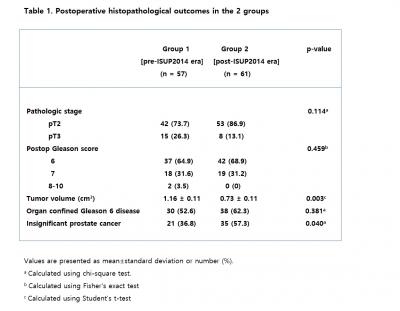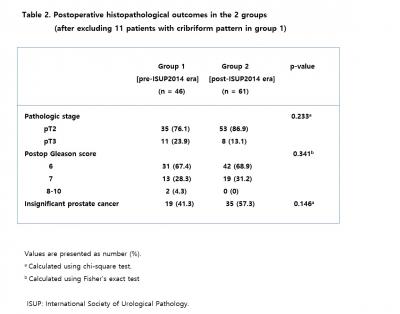|
Cancer - Prostate(구연)
|
(E-133)
|
|
|
능동적 감시 (active surveillance) 프로토콜의 예측 정확도: International Society of Urological Pathology (ISUP)-2014 전, 후에 따른 비교 연구 |
가톨릭관동대학교 의과대학 비뇨기과학교실,
연세대학교 의과대학 1병리학교실, 2비뇨기과학교실
|
| 정문수, 조남훈1, 윤병일, 이승환2 |
Purpose: To analyze the difference in the prediction accuracy with an AS protocol between two eras (pre-International Society of Urological Pathology (ISUP)-2014 vs. post-ISUP2014).
Methods: We retrospectively analyzed 118 candidates for AS who underwent radical prostatectomy between 2009 and 2017. We divided our patients into two groups (group 1 [n=57], operation date 2009–2015; group 2 [n=61], operation date 2016–2017). Pathologic slides in group 1 were reviewed to distinguish men with cribriform pattern (CP) because the determination of GSs in old era had been based on pre-ISUP2014 classification. Postoperative outcomes in the two eras were analyzed twice: first, all men in group 1 vs. group 2; second, the remaining men after excluding those with CPs in group 1 vs. group 2.
Results: The proportion of men with insignificant prostate cancer (iPCa) was significantly lower in group 1 than in group 2 (36.8% vs. 57.3%, p=0.040). After excluding 11 men with CPs from group 1, those remaining (46 men) were compared again with group 2. In this analysis, the proportion of men with iPCa was similar between the two groups (old vs. contemporary era: 41.3% vs. 57.3%, p=0.146). 9 of 11 men with CP had violated the criteria for iPCa in the earlier comparison.
Conclusions: The accuracy of the AS protocol for predicting iPCa has been affected by the coexistence of CPs and pure Gleason 6 tumors in the pre-ISUP2014 era. We suggest to use only contemporary (post-ISUP2014) data to analyze the prediction accuracy with AS protocols in future studies. |
  |
|
keywords : prostatectomy, neoplasm grading, active surveillance |
|

